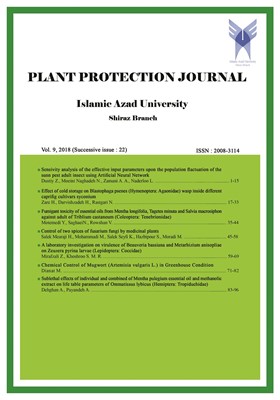-
-
List of Articles
-
Open Access Article
1 - Sensivity analysis of the effective input parameters upon the population flactuation of the sunn pest adult insect using Artificial Neural Network
Zahra Dustiy Naser Moeini naghadeh Abbas Ali Zamani Leila Naderloo -
Open Access Article
2 - Effect of cold storage on Blastophaga psenes (Hymenoptera: Agaonidae) wasp inside different caprifig cultivars syconium
Hamid Zare Hadi Darvishzadeh Nowzar Rastegari -
Open Access Article
3 - Fumigant toxicity of essential oils from Mentha longifolia, Tagetes minuta and Salvia macrosiphon against adult of Triblium castaneum
Yasamin Motemedi Nazila Saghaei Vahid Rowshan -
Open Access Article
4 - Control of two species of fusarium fungi by medicinal plants
Hadi Salek Meraji Meisam Mohammadi Kazem Salek Seyfi Saeed Hazbipour Mohsen Moradi -
Open Access Article
5 - A laboratory investigation on virulence of Beauveria bassiana and Metarhizium anisopliae on Zeuzera pyrina larvae
Zahra Mirafzali Sayed Mohammad Reza Khoshroo -
Open Access Article
6 - Chemical Control of Mugwort (Artemisia vulgaris L.) in Greenhouse Condition
Marjan Diyanat -
Open Access Article
7 - Sublethal effects of individual and combined of Mentha pulegium essential oil and methanolic extract on life table parameters of Ommatissus lybicus
Azita Dehghan Arezoo Payandeh
-
The rights to this website are owned by the Raimag Press Management System.
Copyright © 2021-2025







